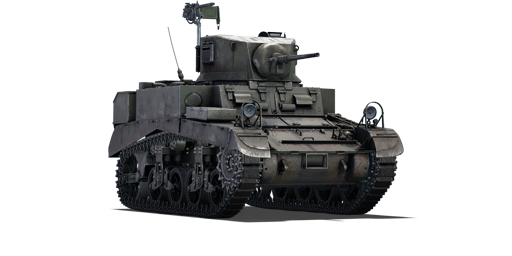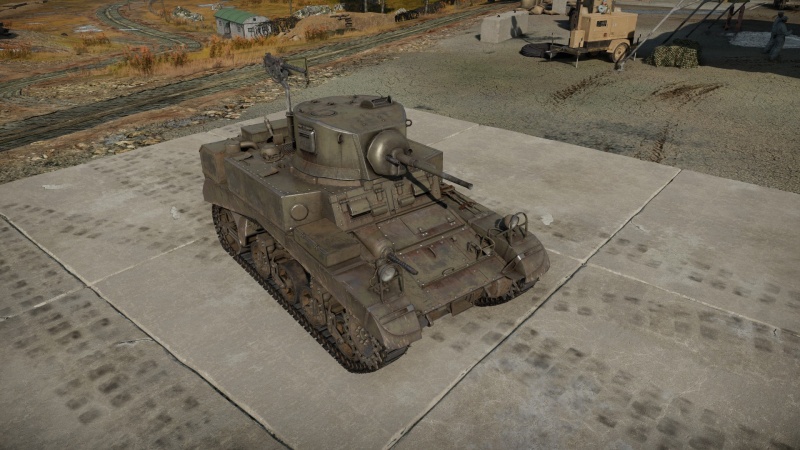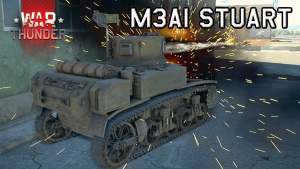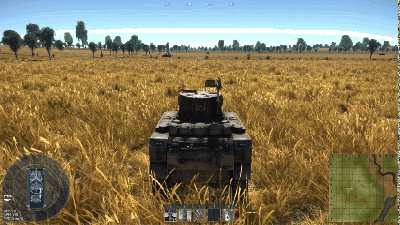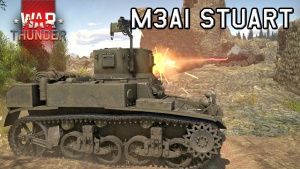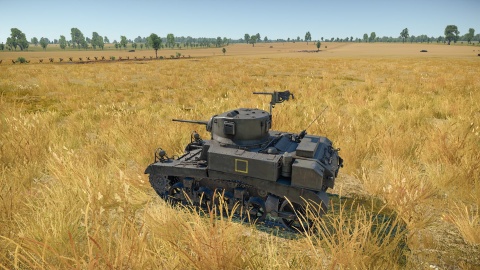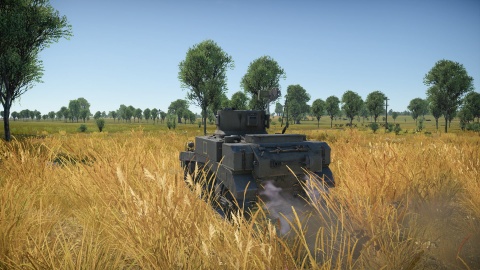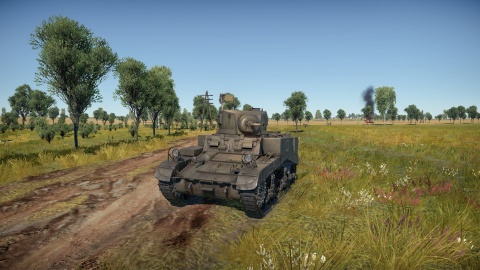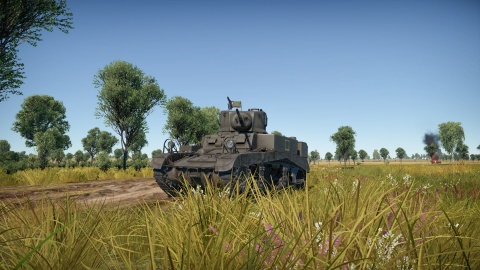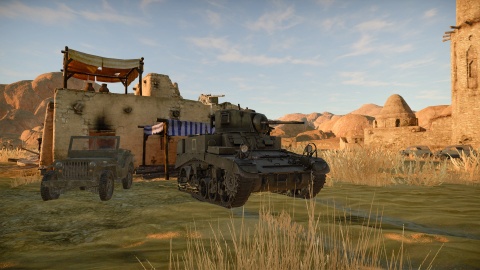Difference between revisions of "Stuart III"
(Edits) |
m (Added to intro, clarified some numbers) |
||
| Line 11: | Line 11: | ||
== Description == | == Description == | ||
<!-- ''In the description, the first part should be about the history of the creation and combat usage of the vehicle, as well as its key features. In the second part, tell the reader about the ground vehicle in the game. Insert a screenshot of the vehicle, so that if the novice player does not remember the vehicle by name, he will immediately understand what kind of vehicle the article is talking about.'' --> | <!-- ''In the description, the first part should be about the history of the creation and combat usage of the vehicle, as well as its key features. In the second part, tell the reader about the ground vehicle in the game. Insert a screenshot of the vehicle, so that if the novice player does not remember the vehicle by name, he will immediately understand what kind of vehicle the article is talking about.'' --> | ||
| − | The '''{{Specs|name}}''' is a rank {{Specs|rank}} British light tank {{Battle-rating}}. It was introduced in [[Update "Starfighters"]]. | + | The '''{{Specs|name}}''' is a rank {{Specs|rank}} British light tank {{Battle-rating}}. It was introduced in [[Update "Starfighters"]]. The main difference from its predecessor, the [[Stuart I]], is a welded turret that has thicker mantlet armor and better sloping, as well as a lower profile thanks to the removal of the cupola. This turret also boasts the upgraded M6 cannon, which can fire higher-penetrating versions of the previous ammo. The transmission is also improved, and is capable of slightly higher speeds both forward and backward. |
== General info == | == General info == | ||
| Line 19: | Line 19: | ||
<!-- ''Describe armour protection. Note the most well protected and key weak areas. Appreciate the layout of modules as well as the number and location of crew members. Is the level of armour protection sufficient, is the placement of modules helpful for survival in combat? If necessary use a visual template to indicate the most secure and weak zones of the armour.'' --> | <!-- ''Describe armour protection. Note the most well protected and key weak areas. Appreciate the layout of modules as well as the number and location of crew members. Is the level of armour protection sufficient, is the placement of modules helpful for survival in combat? If necessary use a visual template to indicate the most secure and weak zones of the armour.'' --> | ||
| − | Being a light tank the Stuart III has fairly thin armour, it can generally protect against most machine guns and some smaller (20mm) cannons, but will usually not stand up against the main weapons of most enemy tanks at its battle rating. There is a fair amount of empty space inside the tank | + | Being a light tank the Stuart III has fairly thin armour, it can generally protect against most machine guns and some smaller (20mm) cannons, but will usually not stand up against the main weapons of most enemy tanks at its battle rating. There is a fair amount of empty space inside the tank thanks to the addition of seats for the turret crew. This means that some poorly placed shots can go through your tank without causing much damage. |
'''Armour type:''' | '''Armour type:''' | ||
| Line 30: | Line 30: | ||
! Armour !! Front !! Sides !! Rear !! Roof | ! Armour !! Front !! Sides !! Rear !! Roof | ||
|- | |- | ||
| − | | Hull || 38.1 mm (18°) ''Driver Port'' <br> 15.8 mm (69°) ''Front Glacis'' | + | | Hull || 38.1 mm (18°) ''Driver Port'' <br> 15.8 mm (69°) ''Front Glacis'' <br> 44.4 mm (5-43°) ''Lower Glacis'' || 25.4 mm || 25.4 mm || 12.7 mm |
|- | |- | ||
| − | | Turret || 50.8 mm || 31.8 mm || 31.8 mm || 12.7 mm | + | | Turret || 50.8 mm ''Mantlet'' <br> 38.1 mm (13°) ''Turret Face'' || 31.8 mm || 31.8 mm || 12.7 mm |
|- | |- | ||
|} | |} | ||
Revision as of 14:32, 23 August 2021
| This page is about the British light tank Stuart III. For other versions, see M3 Stuart (Family). |
Contents
Description
The Stuart III is a rank British light tank with a battle rating of (AB), (RB), and (SB). It was introduced in Update "Starfighters". The main difference from its predecessor, the Stuart I, is a welded turret that has thicker mantlet armor and better sloping, as well as a lower profile thanks to the removal of the cupola. This turret also boasts the upgraded M6 cannon, which can fire higher-penetrating versions of the previous ammo. The transmission is also improved, and is capable of slightly higher speeds both forward and backward.
General info
Survivability and armour
Being a light tank the Stuart III has fairly thin armour, it can generally protect against most machine guns and some smaller (20mm) cannons, but will usually not stand up against the main weapons of most enemy tanks at its battle rating. There is a fair amount of empty space inside the tank thanks to the addition of seats for the turret crew. This means that some poorly placed shots can go through your tank without causing much damage.
Armour type:
- Rolled homogeneous armour
- Cast homogeneous armour (Gun mantlet)
| Armour | Front | Sides | Rear | Roof |
|---|---|---|---|---|
| Hull | 38.1 mm (18°) Driver Port 15.8 mm (69°) Front Glacis 44.4 mm (5-43°) Lower Glacis |
25.4 mm | 25.4 mm | 12.7 mm |
| Turret | 50.8 mm Mantlet 38.1 mm (13°) Turret Face |
31.8 mm | 31.8 mm | 12.7 mm |
Mobility
| Game Mode | Max Speed (km/h) | Weight (tons) | Engine power (horsepower) | Power-to-weight ratio (hp/ton) | |||
|---|---|---|---|---|---|---|---|
| Forward | Reverse | Stock | Upgraded | Stock | Upgraded | ||
| Arcade | Expression error: Unexpected * operator. | 406 | Expression error: Unexpected round operator. | __.__ | |||
| Realistic | 232 | Expression error: Unexpected round operator. | __.__ | ||||
The Stuart III has competitive mobility with a ratio of 20.8 hp per ton. At lower speeds (5-10 km/h) the turning can feel rather sluggish, but once a bit of forward movement is applied and the speed is increased the turning will feel much smoother and faster. The forward drive of the Stuart III can max out at 47 km/h off-road and 58 km/h on-road which will usually allow you to reach capture points or desirable camping spots quickly. The 6 km/h reverse speed of the Stuart III is certainly usable in most situations.
Modifications and economy
Armaments
Main armament
The main weapon on the Stuart III is a 37 mm M6 cannon featuring two rounds, AP & APCBC. This is a fairly standard gun for early American tanks as it is also featured on the M5A1, M22 & LVT(A)(1) although some of these vehicles also include a HE round that the Stuart III lacks. This gun packs a fierce punch if aiming at the correct area and firing at the correct distance. It is a small calibre fast-firing gun with a maximum penetration of 84 mm at 100 m (M51B1/B2 shell), being able to penetrate most of the opponents it will face. The penetration power and gun accuracy drop a lot beyond 500 m and become unreliable past 700 m. The gun is equipped with a vertical stabiliser, giving the Stuart III a huge advantage in some cases as you can fire precisely while moving, but keep in mind that it activates only when the tank is driving under 10 km/h.
While it lacks the post-penetration damage to disable most enemies in one shot, it can quickly finish them off with its fast reload. Knowledge of enemy vehicle layouts is essential with ammunition lacking post-penetration explosive damage. Make sure to target modules and crew positions to maximise the damage. Disabling the enemy gunner on your first shot will be critical to win engagements as you'll most likely need several shots to destroy an enemy vehicle.
| 37 mm M6 | Turret rotation speed (°/s) | Reloading rate (seconds) | |||||||||||
|---|---|---|---|---|---|---|---|---|---|---|---|---|---|
| Mode | Capacity | Vertical | Horizontal | Stabilizer | Stock | Upgraded | Full | Expert | Aced | Stock | Full | Expert | Aced |
| Arcade | 106 | -10°/+20° | ±180° | Vertical | 19.04 | 26.35 | 32.00 | 35.39 | 37.65 | 3.77 | 3.33 | 3.07 | 2.90 |
| Realistic | 11.90 | 14.00 | 17.00 | 18.80 | 20.00 | ||||||||
Ammunition
| Penetration statistics | |||||||
|---|---|---|---|---|---|---|---|
| Ammunition | Type of warhead |
Penetration @ 0° Angle of Attack (mm) | |||||
| 10 m | 100 m | 500 m | 1,000 m | 1,500 m | 2,000 m | ||
| M74B1 | AP | 79 | 76 | 65 | 54 | 45 | 37 |
| M51B1/B2 | APCBC | 87 | 84 | 73 | 60 | 50 | 41 |
| Shell details | |||||||||
|---|---|---|---|---|---|---|---|---|---|
| Ammunition | Type of warhead |
Velocity (m/s) |
Projectile Mass (kg) |
Fuse delay (m) |
Fuse sensitivity (mm) |
Explosive Mass (TNT equivalent) (g) |
Ricochet | ||
| 0% | 50% | 100% | |||||||
| M74B1 | AP | 883 | 0.87 | N/A | N/A | N/A | 47° | 60° | 65° |
| M51B1/B2 | APCBC | 883 | 0.87 | N/A | N/A | N/A | 48° | 63° | 71° |
Ammo racks
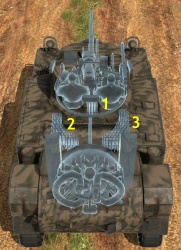
| Full ammo |
1st rack empty |
2nd rack empty |
3rd rack empty |
Visual discrepancy |
|---|---|---|---|---|
| 106 | 71 (+35) | 36 (+70) | 1 (+105) | No |
Machine guns
The Stuart III employs a turret top machine gun and a coaxial machine gun, both of which are the same 7.62 mm M1919A4, these guns are limited to a single AP & T belt type with up to 10 mm of penetration.
The machine gun is only enough to destroy poorly protected vehicles such as the AS 42, Flakpanzer I, and GAZ-AAA. The penetration of around 10 mm is not enough to go through the frontal armour of not-so-weakly-armoured tanks like SU-5-1, Panzerjager I, or 15cm sIG 33 B Sfl. If you are skilled, the two machine guns can be used effectively against low-flying biplanes.
| 7.62 mm M1919A4 | ||||
|---|---|---|---|---|
| Mount | Capacity (Belt) | Fire rate | Vertical | Horizontal |
| Coaxial | 3,200 (250) | 500 | N/A | N/A |
| Pintle | 3,000 (250) | 500 | -5°/+70° | ±60° |
Usage in battles
Due to its light armour, it is advisable not to use the Stuart III frontally at closer ranges, especially not against higher rated enemy vehicles that will go through your strongest frontal armour (50.8mm) without issue. The ideal tactic to use is to employ your competitive speed to flank the enemy and find a position that will allow you to attack them will little resistance, even in a match against higher rated enemy vehicles your rounds will have no issue going through the side armour of said enemy vehicles, common maps such as Eastern Europe and Cargo Port offer clear opportunity's to flank the enemy vehicles with good amounts of cover, this is especially clear on Eastern Europe where you can flank on the other side of the river that runs through the map, this puts you at close range to the side of enemy vehicles, allowing you to prevent them reaching capture points such as the central B point.
To take down enemy vehicles it is advisable to destroy both their turret and engine to prevent escape and stop them engaging you or your allies, due to the fast reload (at best 2.9s) you can hit both parts of an enemy quickly, usually before they can fire back, if they are still not dead after the gun and engine have been hit, shots into the crew compartment should finish the job, but most enemies are usually eliminated by the first 2 shots, it is common for any side shot against an enemy to pen and cause a fair level of damage, even if the enemy is not killed your fast reload will grant you a second chance quickly to place an adjusted shot into the enemy. Even at longer ranges, the Stuart III can be a competent sniper, especially if facing lighter vehicles with flat armour or the side armour of a targeted enemy, firing from long range is another way to ensure that your light armour does not hold you back, being at long range will usually prevent or make it difficult for enemies to successfully hit your vehicle.
Enemies worth noting:
Specific enemy vehicles that bear mentioning are firstly any Germans with the 20 mm KwK/FlaK38 cannon, this gun might be small but can have up too 64 mm of penetration, which is enough to go through the Stuart III at almost any point, these guns can also fire 10 rounds at 280 rounds/min before having to reload the clip, this means that they will very easily take out your crew before you have a chance to respond, as far as countering the best chance you have is to angle your frontal armour which can make it difficult for the PzGr 40 rounds to pen. Keeping your distance to those tanks will also help, as their cannons lose all penetration after 500-700 m.
The Russian T-50 and T-126 are vehicles you will also see commonly, these have fairly thick & angled frontal armour that will prevent you from easily getting through, these tanks also poses an APHEBC round that will destroy you in one shot with little difficulty, to counter you should use your speed to attempt to get a side shot into either the turret or engine if the T-50 cannot move you can outrun its turret and finish it without much difficulty.
It is likely that the M3 will encounter some rough heavies, like the B1 bis. The best tactic against this type of targets is to use the M3A3's fast speed, get within 200 m from then and attack, with shooting at point-blank range being the most effective way. Before conducting an attack, check the M3A3's and the enemy's surroundings to make sure no one will ambush the M3A3. While charging, use the M3A3's quick turns to suddenly change direction to avoid being shot if they are aiming and firing at the M3A3. Once the tank is at the ideal distance, manoeuvre so that the gun is vertical to their armour. Do not shoot if the enemy is angling! The small calibre 37 mm gun is very likely to bounce off or not penetrate against sloped armour.
For the B1 specifically, either aim for the near-vertical frontal armour plate at the right side of the hull, or the turret ring to incapacitate the commander/gunner. Or simply move to its side and knock out the crews one by one by hitting its flat side armour.Pros and cons
Pros:
- Frontal armour useful against MGs and light cannons
- Competitive mobility
- Reliable gun with a good rate of fire
- Ammo has good penetration
- Lots of empty space, so poorly aimed shots tend to not do much damage
Cons:
- All crew members can be eliminated by a well-placed shot
- Brakes are weak
- Turning is sluggish at slower speeds
- No AP ammunition with HE filler
History
Development
The American light tank design prior to World War II, the M2 light tank, was seen as obsolete after observing Germany's Panzer forces tear through Europe. The design was to be upgraded with more armour, a better suspension, and a new gun recoil system. The revised version was designated the Light Tank M3, which the British named the Stuart. At its basis, the light tank had a 37 mm cannon with a similar layout as the M2 light tank, with the radial engine at the rear and the transmission on the front, though the radial engine was in high demand so the Guiberson diesel T-1210 were fitted in some models to substitute the engine. The design used the VVSS bogie system seen on previous American tank designs. The tank had a crew of four: driver, assistant driver, gunner, and commander, who doubled as the loader.
The first variant of the M3 Stuart light tank was very similar to the M2 light tanks. It had five machine gun armaments scattered around like the M2 but featured better armour and a better cannon with the 37 mm M6 cannon. The design did not have a turret basket for the crew and it was constructed out of rivets, which increased the chance of spalling in the tank. Nevertheless, the first variant M3 saw about 5,811 units produced. The second variant, the Light Tank M3A1 Stuart , featured a new turret with no cupola on it, plus an added gun stabilizer. The machine guns on the hull sides were removed, so now the total machine guns were reduced from five to three. The design also featured a welded armour design to remove the weakness of riveted armour. 4,621 of this variant was produced from May 1942 to February 1943. The most used variant, the M5A1 Stuart, had a completely redesigned hull and turret, with the hull most notably having a full sloping frontal armour than the previous designs. This variant had about 6,810 units produced. All in all, the M3 light tank design and its variants were produced in massive quantities from March 1941 to October 1943 with a total of 25,000 units produced.
Combat usage
The British were the first to use the M3 Stuart in Africa in 1941, using it in Operation Crusader. However, the result ended with heavy losses, due to the better training the German Afrika Korps had compared to the British tank doctrine. The encounter also pointed out many flaws in the M3, mainly the cramped interior and limited operational range, but was praised for its high mobility and reliability when compared to the British contemporary designs. In 1942, the Stuarts were generally kept as recon units rather than combat units, and some were even modified to improve speed and range by removing the turret, and others were converted to armoured personnel carriers and command vehicles. Though the British used it extensively, it was still in small proportion compared to American usage. The Soviet Union was also another user of the M3 but found it unfavourable due to their own logistics, plus it was not made to withstand the Russian Rasputitsa or even the winter. The Soviet eventually turned down any more offers for the Stuart by 1943. The M3s also supported the British and Chinese forces in Asia against the Japanese Army, and also France and Yugoslavia in Europe against the German Wehrmacht.
The Americans used it widely in both operational theatres. In the Pacific, the M3s were the first tanks America used in a tank vs. tank operation against the Imperial Japanese Army, where five M3s fought Type 95 Ha-Gos in the Phillippines. Though the Stuarts were newer than the Japanese tank designs by about five years, they were seen as equal in performance and firepower, but the M3 benefited by the support of the American industry arm. The Stuarts served in the Pacific slightly better than its heavier counterparts such as the M4 Shermans due to its lighter weight and manoeuvrability in the poor jungle terrain, but the M3 Stuarts in the Pacific were gradually replaced by M4 Shermans due to heavy losses from its thinner armour. The M3 was also some of the first US tanks to be converted into flamethrower tanks, named as the "Satan". The Satan tanks provided favourable results to the concept of a flamethrower tank and were replaced by flamethrower-equipped M4 Shermans in 1945.
In Europe, the M3 formed a large part of the American tank battalions, though following the British path by sidelining the Stuarts from combat duties after heavy losses and to serve alongside Shermans as scouting units. A typical tank battalion for the US Army consisted of three companies of Shermans and one of Stuarts. Other than scouting, the M3s were also used in cavalry roles and infantry support since their cannon are unable to compete with the German tank designs. Despite their dwindling capabilities in battle, the M3 was kept in service up until the end of the war due to the large production numbers.
After World War II, the Stuarts were given out as cheap surplus, countries such as China, India, and Pakistan picked up a few and used them in their conflicts. Portuguese also picked up a few M3s for the war in Angola, and the South African Corps continued using the Stuarts until 1955, where some were still kept in service until 1968 due to available parts. Today, Paraguay is still a user of the M3 light tanks, though as the only tracked armour used in the country.
The Stuart light tank design was also quite versatile that it was made into different variants for different roles on the battlefield. It served as an infantry support vehicle as to the 75mm GMC M8 and experiments were also taken to see if it could be adapted to an anti-aircraft gun and a flamethrower as well. However, the M3 was becoming an ageing design with inferior armour, cramped interior layout, and a small 37 mm gun, so a program to replace the light tank began in 1943 and became the M24 Chaffee, which would eventually replace the M3 Light Tank mostly after World War II.
In-game description
Production of the M3A1 Stuart modification got underway in April 1942, with its primary changes affecting turret construction. The turret was a horseshoe-shaped M3, though it did not have a cupola, and two triangular hatches on its roof served as exits for the crew. The gunner and reloader had periscopes. The turret rotated using a power traverse as opposed to the manually rotated M3. Its faster rotation speed required changes in its construction, in particular a basket fitted with seats for the crew members.
The M23 mantlet was fitted with a 37 mm M6 cannon featuring a gyro stabilizer that significantly boosted accuracy while on the move. That did, however, require more training for gunners, a difficult assignment under battlefield conditions. The sponson-mounted immobile M1919A4 machine guns were replaced with additional ammunition storage, pushing the tank's capacity to 116 shells and 6,400 bullets.
From April to August of 1942 the M3A1 was produced alongside the M3. Changes were made gradually, meaning that some later M3s featured welded bodies and new turrets. They lacked, however, the basket and power traverse, and were called Stuart Hybrids. Some early M3A1s had sponson-mounted machine guns (the intervening models plugged up the openings) and riveted bodies. By the end of February 1943, 4,621 M3A1s had been assembled, 211 of them with the Guiberson T-1020-4 engines (called Stuart IVs by the British). It is worth noting that the M3A1s with welded bodies should have been designated M3A2s, though that never actually happened.
Media
Media
- Skins
- Images
See also
Links to the articles on the War Thunder Wiki that you think will be useful for the reader, for example:
- reference to the series of the vehicles;
- links to approximate analogues of other nations and research trees.
External links
Paste links to sources and external resources, such as:
- topic on the official game forum;
- other literature.
| Britain light tanks | |
|---|---|
| A13 | A13 Mk I · A13 Mk I (3rd R.T.R.) · A13 Mk II · A13 Mk II 1939 |
| A15 | Crusader II · Crusader "The Saint" · Crusader III |
| A17 | Tetrarch I |
| IFV | Warrior · Desert Warrior (Kuwait) |
| Wheeled | Daimler Mk II · AEC Mk II · Fox · Vickers Mk.11 |
| Other | VFM5 |
| South Africa | |
| SARC | SARC MkIVa · SARC MkVI (2pdr) · SARC MkVI (6pdr) |
| Ratel | Ratel 90 · Ratel 20 |
| Rooikat | Rooikat Mk.1D · Rooikat 105 · Rooikat MTTD |
| Other | Concept 3 · Eland 90 Mk.7 |
| USA | Stuart I · Stuart III |


